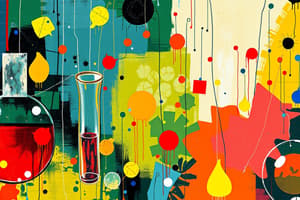Podcast
Questions and Answers
What are the 5 science practices mentioned in the text?
What are the 5 science practices mentioned in the text?
Asking Questions, Developing and Using Models, Conducting Investigations, Analyzing and Interpreting Data, Drawing Conclusions and Communicating Results
How does CER play a role in the scientific process?
How does CER play a role in the scientific process?
Claims are tested through evidence and reasoning, helping scientists refine and improve their understanding of the world.
Give an example of a claim related to climate change mentioned in the text.
Give an example of a claim related to climate change mentioned in the text.
The Earth's climate is changing, and human activities are the primary cause.
How can scientists improve their understanding of climate change according to the text?
How can scientists improve their understanding of climate change according to the text?
Why is understanding CER and its relationship to science practices crucial?
Why is understanding CER and its relationship to science practices crucial?
Flashcards are hidden until you start studying
Study Notes
Understanding CER: Claim, Evidence, Reasoning, and Science Practices
In the realm of scientific inquiry, the process of forming and justifying claims relies on a robust foundation of evidence and reasoning. This article will explore the interconnected concepts of Claim, Evidence, Reasoning (CER), and how they intersect with science practices.
Claim
A claim is a statement about the world that can be supported or challenged. It can be an assertion about a fact, hypothesis, or theory. Claims are not inherently true or false but can be tested to determine their validity. For example, a claim like "Grapes originated in ancient Persia" can be tested through historical evidence and genetic studies.
Evidence
Evidence is the data, observations, and information that can support or refute a claim. Evidence can take various forms, such as data from experiments, observations, or expert testimony. In the example above about the origin of grapes, historical records, archaeological findings, and genetic analyses could serve as evidence to support or refute the claim.
Reasoning
Reasoning is the process of connecting evidence to claims. It involves using logical thinking to build a coherent argument or explanation. Reasoning can take various forms, such as deductive reasoning, inductive reasoning, or abductive reasoning. For example, when analyzing the evidence for the origin of grapes, a scientist might use inductive reasoning to draw conclusions based on patterns observed in the data.
Science Practices
Scientific practices refer to the methods used by scientists to conduct and communicate their work. These practices include:
-
Asking Questions: An essential part of scientific inquiry, asking questions allows scientists to explore the world around them and identify areas worthy of investigation.
-
Developing and Using Models: Models are simplified representations of complex systems that help scientists to understand and predict phenomena.
-
Conducting Investigations: Through experiments, observations, and other methods, scientists gather data and evidence to test their claims.
-
Analyzing and Interpreting Data: Scientists analyze data to identify patterns and relationships, which they then interpret to support or refute their claims.
-
Drawing Conclusions and Communicating Results: Based on their analysis and interpretation of data, scientists draw conclusions and communicate their findings to the scientific community and the public.
CER and Science Practices
As we've seen, CER plays an essential role in the scientific process. Claims are tested through evidence and reasoning, and scientific practices like asking questions, developing and using models, conducting investigations, analyzing and interpreting data, and drawing conclusions and communicating results help scientists to refine and improve their understanding of the world.
For example, consider the claim, "The Earth's climate is changing, and human activities are the primary cause." This claim can be tested through evidence such as global temperature data, atmospheric carbon dioxide levels, and ocean acidification data. Scientists use reasoning to analyze these data and develop models to better understand the mechanisms and consequences of climate change. By following the scientific practices, scientists can ask questions, conduct investigations, analyze and interpret data, and communicate their findings to the public, ultimately helping to inform policy decisions and promote a better understanding of the Earth's climate system.
In conclusion, understanding CER and its relationship to science practices is crucial for scientists and students alike. By developing and refining their claims, gathering and analyzing evidence, and using reasoning to build coherent arguments, scientists can make new discoveries, improve our understanding of the world, and ultimately help to address some of the most pressing challenges facing humanity today.
Studying That Suits You
Use AI to generate personalized quizzes and flashcards to suit your learning preferences.





